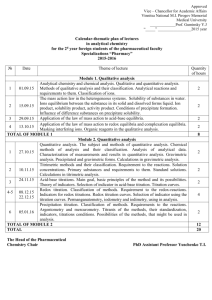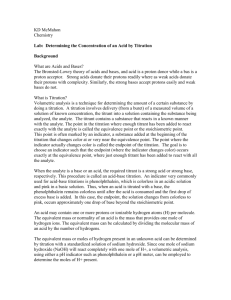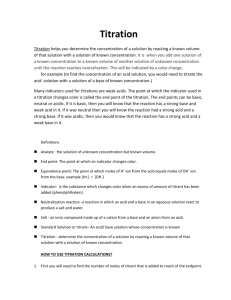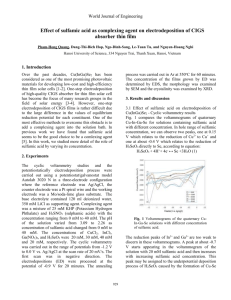POTENTIOMETRIC TITRATION OF AN ACID MIXTURE
advertisement
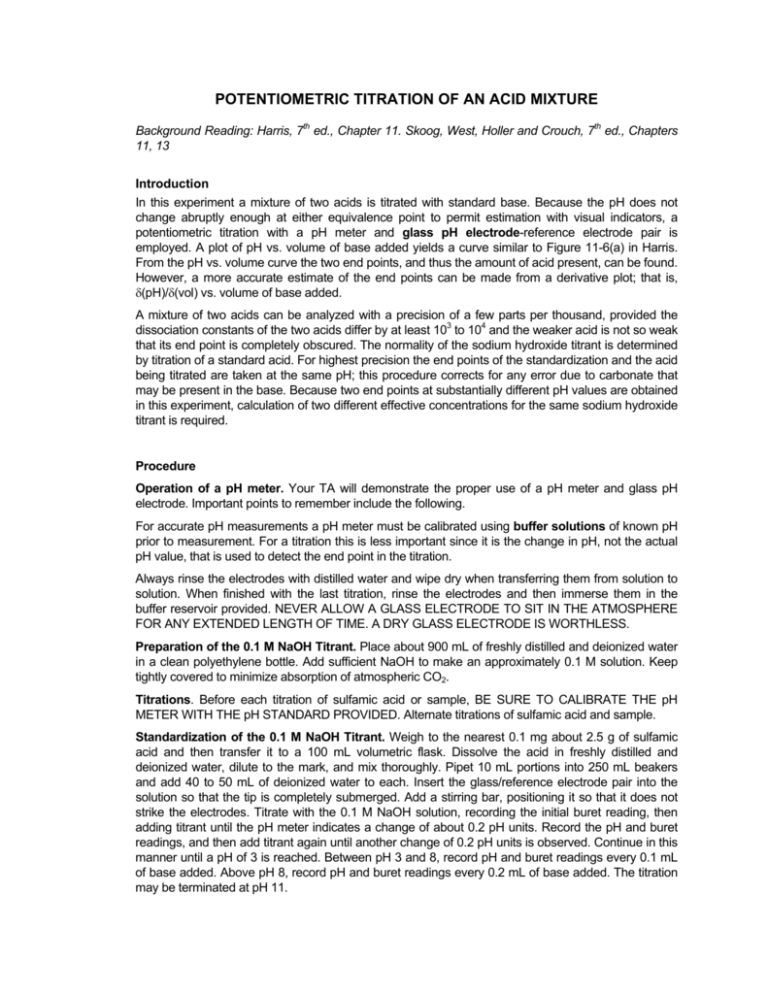
POTENTIOMETRIC TITRATION OF AN ACID MIXTURE Background Reading: Harris, 7th ed., Chapter 11. Skoog, West, Holler and Crouch, 7th ed., Chapters 11, 13 Introduction In this experiment a mixture of two acids is titrated with standard base. Because the pH does not change abruptly enough at either equivalence point to permit estimation with visual indicators, a potentiometric titration with a pH meter and glass pH electrode-reference electrode pair is employed. A plot of pH vs. volume of base added yields a curve similar to Figure 11-6(a) in Harris. From the pH vs. volume curve the two end points, and thus the amount of acid present, can be found. However, a more accurate estimate of the end points can be made from a derivative plot; that is, δ(pH)/δ(vol) vs. volume of base added. A mixture of two acids can be analyzed with a precision of a few parts per thousand, provided the dissociation constants of the two acids differ by at least 103 to 104 and the weaker acid is not so weak that its end point is completely obscured. The normality of the sodium hydroxide titrant is determined by titration of a standard acid. For highest precision the end points of the standardization and the acid being titrated are taken at the same pH; this procedure corrects for any error due to carbonate that may be present in the base. Because two end points at substantially different pH values are obtained in this experiment, calculation of two different effective concentrations for the same sodium hydroxide titrant is required. Procedure Operation of a pH meter. Your TA will demonstrate the proper use of a pH meter and glass pH electrode. Important points to remember include the following. For accurate pH measurements a pH meter must be calibrated using buffer solutions of known pH prior to measurement. For a titration this is less important since it is the change in pH, not the actual pH value, that is used to detect the end point in the titration. Always rinse the electrodes with distilled water and wipe dry when transferring them from solution to solution. When finished with the last titration, rinse the electrodes and then immerse them in the buffer reservoir provided. NEVER ALLOW A GLASS ELECTRODE TO SIT IN THE ATMOSPHERE FOR ANY EXTENDED LENGTH OF TIME. A DRY GLASS ELECTRODE IS WORTHLESS. Preparation of the 0.1 M NaOH Titrant. Place about 900 mL of freshly distilled and deionized water in a clean polyethylene bottle. Add sufficient NaOH to make an approximately 0.1 M solution. Keep tightly covered to minimize absorption of atmospheric CO2. Titrations. Before each titration of sulfamic acid or sample, BE SURE TO CALIBRATE THE pH METER WITH THE pH STANDARD PROVIDED. Alternate titrations of sulfamic acid and sample. Standardization of the 0.1 M NaOH Titrant. Weigh to the nearest 0.1 mg about 2.5 g of sulfamic acid and then transfer it to a 100 mL volumetric flask. Dissolve the acid in freshly distilled and deionized water, dilute to the mark, and mix thoroughly. Pipet 10 mL portions into 250 mL beakers and add 40 to 50 mL of deionized water to each. Insert the glass/reference electrode pair into the solution so that the tip is completely submerged. Add a stirring bar, positioning it so that it does not strike the electrodes. Titrate with the 0.1 M NaOH solution, recording the initial buret reading, then adding titrant until the pH meter indicates a change of about 0.2 pH units. Record the pH and buret readings, and then add titrant again until another change of 0.2 pH units is observed. Continue in this manner until a pH of 3 is reached. Between pH 3 and 8, record pH and buret readings every 0.1 mL of base added. Above pH 8, record pH and buret readings every 0.2 mL of base added. The titration may be terminated at pH 11. Potentiometric Titration of an Acid Mixture, Page 2 For the second and subsequent titrations only the initial pH and data near the equivalence points (pH 3-10) need be recorded, so these titrations can be performed rather quickly. MAKE SURE TO ALTERNATE SULFAMIC ACID AND SAMPLE TITRATIONS. Sulfamic acid, H2NSO3H, is also known as amidosulfonic acid. It has a formula weight of 97.10 g. Titration of an Unknown Mixture of Acids. Obtain a sample acid mixture from the TA in a 100 mL volumetric flask. Dilute to volume with deionized water and mix thoroughly. Pipet 10 mL portions of this solution into 250 mL beakers, add 40 to 50 mL of water to each, and titrate with 0.1 M NaOH. Record the initial pH, then add titrant until the pH meter indicates a change of about 0.2 pH units. Record the pH and buret readings. Continue in this fashion until a pH of 3 is reached. Between pH 3 and 6 (region of the first end point), record the pH after the addition of 0.1 mL increments of base. Then, record the pH after addition of each 0.2 mL of base from pH 6 to 8, each 0.1 mL from pH 8 to 10.5 (region of the second end point), and finally each 0.2 mL until pH 11. For the second and subsequent titrations only the initial pH and data near the equivalence points need be recorded, so these titrations can be performed rather quickly. MAKE SURE TO ALTERNATE SULFAMIC ACID AND SAMPLE TITRATIONS. Calculations Using Excel, plot the data for each titration (pH vs. volume of base added). The sulfamic acid (standardization) titrations will have one end point, the unknown mixture two. Sodium carbonate present in the NaOH titrant causes the molarity of the solution to vary as a function of the strength of the acid. The best way to correct for the carbonate error is to obtain two effective NaOH molarities from the standardization curves. This process is illustrated in the figure below. On the mixture titration curve find the pH at each end point. For purposes of illustration assume one is at pH 5 and the other at pH 10. On the sulfamic acid titration curve find the volumes of NaOH required to titrate to pH = 5 and to pH = 10. Use the first volume and the mmol of sulfamic acid used to find the effective molarity of the NaOH in titrating the strong acid and the second volume and the same mmol of sulfamic acid used to find the effective molarity of the NaOH in titrating the weak acid. Thus, the NaOH titrant will have a 'strong acid' molarity, Ms, and a 'weak acid' molarity, Mw. If there is no carbonate error, the pH vs. volume curves will be essentially vertical in the region of these end points, and Ms and Mw will be indistinguishable. The end points for the unknown acid titration correspond to the inflection points in the pH vs. volume curves. However, these points are more accurately determined by a derivative plot; δ(pH)/δ(vol) vs. volume. The end points correspond to the tops of the peaks that will be apparent. Potentiometric Titration of an Acid Mixture, Page 3 Report For sulfamic acid and your unknown report one titration curve plot and one derivative plot. In tabular form report Ms and Mw and the average and standard deviation for each for the replicate titrations of your NaOH solution. Report the mmoles of strong acid and weak acid in your mixture for at least three determinations. Report the average and standard deviation for your determinations and your best estimate of the true values.



